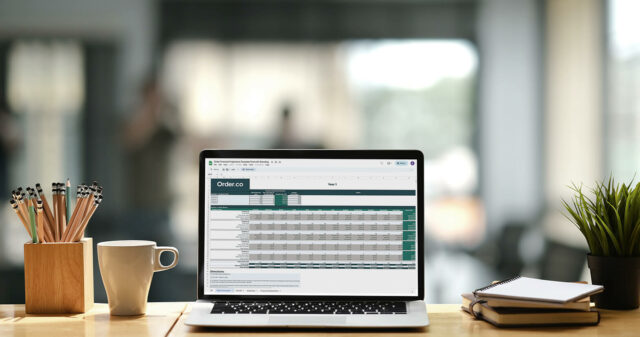Notes Payable vs. Accounts Payable: The Difference Cuts Cost

Notes Payable vs. Accounts Payable: The Difference Cuts Cost
Accounts payable (AP) and notes payable (NP) are often used interchangeably, but in reality, they operate differently and serve distinct purposes within your financial strategy.
To properly manage either payable category, granular spend visibility is essential. Without it, the benefit of strategic financing can be diminished or even become a vector for financial risk.
We will define and contrast accounts payable and notes payable and illustrate how financing strategies offer maximum growth opportunities when paired with a dynamic procurement management tool. First, let’s get a clearer understanding of the differences between AP and NP.
Download the free tool: Financial Projections Template
Accounts payable and notes payable defined
Accounts payable and notes payable are liabilities recorded as journal entries in a general ledger (GL) and on the company’s balance sheet.
Accounts payable refers to short-term liability accounts incurred for purchases with vendors and suppliers on credit. Notes payable are long-term liability accounts incurred through financing by banks and other lending institutions. Many business owners and managers assume accounts payable and notes payable are interchangeable terms, but they are not.
Let’s look more closely at the differences:
Accounts payable (AP)
- Short-term debt resulting from purchasing goods and services. These credit purchases are due for repayment within a year or less. (In practice, most suppliers seek Net 30 repayment terms.)
- Purchases do not incur interest within the repayment period and discounts may be offered for early payment.
- These short-term loans are non-collateralized. As long as invoices are paid promptly, suppliers will continue to fulfill new orders.
Notes payable (NP)
- Longer-term obligations to vendors or lending institutions. They have specific terms and maturity periods of either one year or less (short-term) or more than one year (long-term).
- Backed by written promises to repay (called promissory notes) that outline payment terms. Notes include the principal amount issued by the lender, interest payable, payment interval, and security or collateral terms. These elements are encapsulated into a formal lending agreement between the borrower and lender.
- Notes payable are customarily funded by banks, but they may also be paid to other financial institutions.
- Specific due date and repayment schedule. Notes payable are recorded and reported differently from accounts payable.
What are the benefits of long-term notes payable? (LTNP)
Leveraging financing can be an effective way of getting needed supplies and creating growth in the short term for companies that can generate revenue and adhere to repayment terms.
A long-term notes payable agreement helps businesses access needed capital attached to longer repayment terms (12–30 months).
- LNTP agreements are repaid with a set interest rate (like short-term notes payable).
- Long-term notes can be non-collateralized loans used for purchasing supplies or equipment. This gives businesses the funding they need without relinquishing any control over how those funds are used and without needing pre-approval from investors.
- Long-term notes payable provide the capital to invest in future growth, product development, and innovation, freeing up current assets for current operations.
- The LTNP is a low-risk financing option. It increases a company’s debt capacity and, therefore, displays deeper financial stability.
- Interest due can be deducted from the current year’s tax liability, lowering the overall cost of capital financing.
LTNP funding allows businesses to plan beyond day-to-day operations and fund innovation and growth. Using LTNP credit, you improve everyday control while building products and features to increase future revenue.
Pairing a financing strategy with a procure-to-pay solution
Leveraging the power of financing within your business allows you to grow faster, bring products to market within shorter timelines, and get needed supplies and equipment into service without waiting to raise revenue or constraining cash flow.
To make the best use of this strategy, you need strong visibility into procurement activities, and a granular understanding of your current liabilities. Without a process of strict budgetary control, the advantages you gain in securing long-term financing may be lost in poor cash management—you risk overspending on short-term liabilities and finding yourself unable to make payment obligations on your loan agreement when the bills come due.
Strong procure-to-pay (P2P) management helps companies keep a rein on spending and creates an audit trail and a business case for every purchase. Procurement software can build these guardrails into the ordering process so your stakeholders can get what they need without overspending.
You’ll get four basic areas of improvement from a good P2P process:
- Better visibility to optimize spend
- Reduced or eliminated maverick spending
- Streamlined supply chain management to avoid production delays
- Integrated invoice approval and payments to avoid fees and enable discounts
When you procure needed supplies using financing and ensure an effective budgetary process through P2P, you immediately see higher cash flow stability and lower costs. These conditions improve working capital to support growth further.
How does procure-to-pay (P2P) work?
Many businesses operate across several sites and via separate departments that replicate similar activities. It is common for the same goods and services to be needed by these separate departments and sites. Without an established P2P process, each location may end up generating its own supply chain, which often leads to frequent errors.
P2P systematizes every step of the procurement process:
- Requisitioning goods and services
- Selecting and evaluating suppliers
- Receiving and reconciling shipments
- Invoice approval and supplier payments
Goods and services can be requisitioned from the same suppliers across all departments, cleaning up your supply chain and greatly reducing errors.
10 Steps in the procure-to-pay (P2P) process
When each purchase follows a procurement plan with the following steps, it establishes accountability and ensures your business operations are transparent and efficient:
- Identify goods and services to be ordered.
- Raise a purchase requisition.
- Review and approve the requisition.
- Select the appropriate supplier based on known pricing, quality, and delivery standards.
- If there are no existing suppliers, create a list of potential vendors and issue requests for bids.
- Integrate requisitions to create a complete purchase order with specific order and delivery details for each site or department.
- Issue the purchase order to the supplier.
- Receive and approve deliveries.
- Check and approve supplier invoices with three-way matching.
- Pay supplier at the business’s discretion.
- Evaluate supplier performance.
While these steps are possible using a manual process, the volume of accounts and invoices in most companies requires automation to fully realize savings and control.
Using technology to power P2P success
When you understand the difference between accounts payable and notes payable, it is easy to keep them separate and use that difference to your advantage, meeting immediate capital needs and improving value creation.
Here are some of the top benefits of pairing strategic financing with P2P solutions:
Better finances: Good financing strategies with a solid procurement management system ensures your long-term plans are supported with smart short-term spending controls.
More stability: This comprehensive process keeps cash flow smooth and efficient.
Transparency: Automation and centralized data help accounts payable teams retain total visibility through every stage, from requisition to final payment.
Higher accountability: This standard of budgetary control ensures every purchase meets operational standards, adheres to corporate compliance, and stays within budget.
Tighter supply chain: Improved efficiency benefits both the company and its suppliers. P2P makes it easier for suppliers to meet delivery deadlines. This reduces their costs and allows you to renegotiate better prices and terms.
Better liquidity: Your working capital is less strained and more available for other immediate needs. It can also be allocated to future budget plans, including settling promissory notes.
By knowing the differences between notes payable and accounts payable—and learning to leverage each correctly— you can improve your cash flow and grow more effectively. Pair this with a robust P2P platform, and you’ll be set to optimize your finance function and further accelerate success. To learn more about leveraging financing and putting procure-to-pay to work in your procurement practice, watch our on-demand Finance and Automation webinar.
Get started
Schedule a demo to see how Order.co can simplify buying for your business.
"*" indicates required fields



